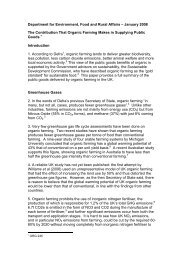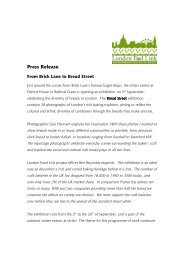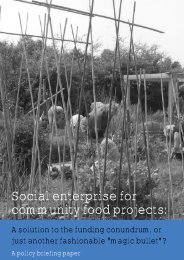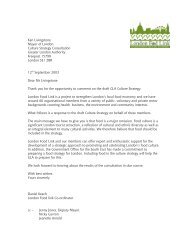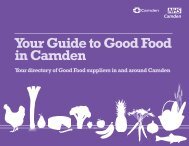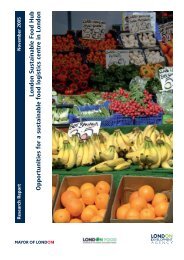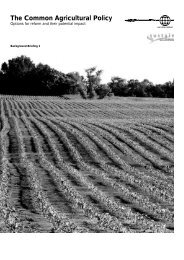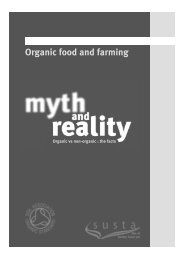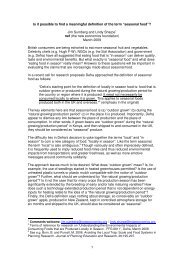Good Food for Camden - Sustain
Good Food for Camden - Sustain
Good Food for Camden - Sustain
Create successful ePaper yourself
Turn your PDF publications into a flip-book with our unique Google optimized e-Paper software.
ForewordEvidence from various respectable scientific sources support the 5A DAY approach to prevent illness and maintain health. However, arecent NHS <strong>Camden</strong> lifestyle survey found that only 32 per cent of<strong>Camden</strong> adults eat the recommended amount of fruit andvegetables.NHS <strong>Camden</strong>, <strong>Camden</strong> Council and <strong>Sustain</strong> have come togetherwith partners in the community, voluntary and business sector todevelop the <strong>Good</strong> <strong>Food</strong> <strong>for</strong> <strong>Camden</strong> strategy, which aims to make<strong>Camden</strong> a healthier place in which to live and work. The role ofNHS organisations, local authorities and voluntary sectororganisations in supporting and promoting a healthier food economyis highlighted in ‘Healthy Weight, Healthy Lives’ 1 , a crossgovernmentstrategy <strong>for</strong> England.We are all aware of the negative effects which result from the waywe currently produce, buy and eat our food. Climate change andunnecessary food and packaging waste all play a significant role incontributing to poor diet and there<strong>for</strong>e poor health in adults andchildren. This is particularly evident in different parts of the borough.This strategy suggests how working together, these key healthchallenges can be overcome by the promotion of, and access to,healthy food <strong>for</strong> all <strong>Camden</strong> residents.We welcome this opportunity to work with council colleagues, thevoluntary sector and community groups to make healthy andsustainable food a part of every <strong>Camden</strong> resident’s daily life.John CarrierNHS <strong>Camden</strong> ChairThe intention of the <strong>Good</strong> <strong>Food</strong> Strategy is to introduce a healthyand environmentally-friendly food system in <strong>Camden</strong>. We want toimprove access to healthy, af<strong>for</strong>dable and locally grown food. Thiswill help us to address obesity and health inequalities.<strong>Good</strong> <strong>Food</strong> <strong>for</strong> <strong>Camden</strong>: The healthy and sustainable food strategy1
AcknowledgementsThis document <strong>for</strong>ms part of the development ofa healthy and sustainable food programme <strong>for</strong><strong>Camden</strong>. It has been commissioned and fundedby NHS <strong>Camden</strong> (<strong>for</strong>mally <strong>Camden</strong> PrimaryCare Trust), working in partnership with <strong>Camden</strong>Council. We would like to acknowledge thesupport and guidance received from <strong>Sustain</strong> andthe Brighton and Hove <strong>Food</strong> Partnership.<strong>Good</strong> <strong>Food</strong> <strong>for</strong> <strong>Camden</strong>: The healthy and sustainable food strategy4
<strong>Good</strong> <strong>Food</strong> FOr <strong>Camden</strong>Introduction<strong>Camden</strong>’s interest in <strong>Good</strong> <strong>Food</strong> comes at an important time, whenpublic concerns about food issues have never been greater. Theworld is in the midst of a recession. Health issues associated witha poor diet, such as obesity and heart disease, continue to poseserious problems – particularly <strong>for</strong> communities living on a lowincome. The UK also urgently needs to reduce its greenhouse gasemissions, dependence on oil, and wasteful water use – not leastin the food system. These are major challenges that <strong>Camden</strong> canplay its part in addressing.NHS <strong>Camden</strong> and the council have important roles to play inimproving the nutritional quality, accessibility, af<strong>for</strong>dability andsustainability of food <strong>for</strong> the borough – especially <strong>for</strong> vulnerable,disadvantaged and lower income communities. Both organisationsare leading members of <strong>Camden</strong>’s Local Strategic Partnership(LSP) and have a strong commitment to <strong>Camden</strong>’s <strong>Sustain</strong>ableCommunity Strategy.<strong>Camden</strong>’s <strong>Sustain</strong>able Community Strategy is a partnershipdocument which sets out a clear vision <strong>for</strong> <strong>Camden</strong> to be aborough of opportunity <strong>for</strong> all by 2012. NHS <strong>Camden</strong> and theCouncil’s commitment to ensuring this vision becomes a reality is akey factor in the development of a more healthy and sustainablefood system <strong>for</strong> the borough through the implementation of the<strong>Good</strong> <strong>Food</strong> <strong>for</strong> <strong>Camden</strong> strategy.5
<strong>Good</strong> <strong>Food</strong> FOr <strong>Camden</strong>What we mean by <strong>Good</strong> <strong>Food</strong>‘<strong>Good</strong> <strong>Food</strong>’ is food that is healthy, of good quality, nutritious,af<strong>for</strong>dable, and sustainable, thereby contributing to reducing healthinequalities whilst also minimising environmental impact. This willequate to nutritionally balanced meals using fresh, locally grown orreared seasonal produce.A healthy diet consists of consuming a wide variety of nutritiousfoods each day, while eating only small amounts of foods high infat (especially saturated), salt and sugar. A healthy balanced diet isbased on a variety of foods from the five food groups in the <strong>Food</strong>Standards Agency’s (FSA) Eatwell Plate (see appendix 1 page 42).There<strong>for</strong>e <strong>Good</strong> <strong>Food</strong> will equate to nutritionally balanced mealsusing fresh, locally grown or reared seasonal produce.Put simply, ‘sustainable food is food that meets the needs of thepresent without compromising the ability of future generations tomeet their own needs’ 2 . <strong>Sustain</strong>able food is bought, consumed andprepared with as little impact on the environment as possible, <strong>for</strong> afair price; makes a positive contribution to the local economy; isgrown locally, in season, and fairly traded; and is grown accordingto audited criteria that includes the environment, ethical trading andanimal welfare.Unsustainable food is likely to be: highly processed; transportedlong distances unnecessarily; grown in heated and or artificially litgreenhouses; grown or reared using chemicals unnecessarily; notlikely to return a good livelihood <strong>for</strong> the people producing it, but thisis not an exhaustive list. These types of processes cause damageto people, animals and the environment and typically rely heavilyon non-renewable resources such as oil and coal.For more details on what is meant by ‘<strong>Good</strong> <strong>Food</strong>’, see:■■■■the <strong>Food</strong> Standards Agency’s Eatwell website:www.eatwell.gov.uk/healthydiet/eatwellplate<strong>Sustain</strong>’s sustainable food guidelines:www.sustainweb.org/sustainablefood6
<strong>Good</strong> <strong>Food</strong> FOr <strong>Camden</strong><strong>Camden</strong>’s population and its challenges<strong>Camden</strong> is a vibrant and diverse inner-London borough with anestimated population of 231,900*. In addition, a quarter of a millionpeople work in <strong>Camden</strong> every day and hundreds of thousands ofvisitors come every year. The number of visitors and peopletravelling through the borough has intensified even further sinceNovember 2007 when <strong>Camden</strong> became the gateway to Europeafter the opening of the Channel tunnel rail link.<strong>Camden</strong> has some of the most affluent and deprived areas in theUK. The borough has high population mobility and is the 57th mostdeprived of the 354 boroughs in England. <strong>Camden</strong> has markedinequalities in health, with male life expectancy varying by morethan ten years across different wards. There is also a large numberof homeless people and high levels of mental health issues.Black and minority ethnic (BME) groups are estimated to make up30 per cent of the borough’s population. The largest BME group in<strong>Camden</strong> is Bangladeshis, who account <strong>for</strong> 6.3 per cent of<strong>Camden</strong>’s population, followed by black Africans (6 per cent) andIrish (4.6 per cent). <strong>Camden</strong>’s residents are comparatively young –only 10 per cent of the population are over 65+, while 42 per centare aged between 20-29 years. This compares with national ratesof 16 per cent and 28 per cent respectively.* Corporate Area Assessment submission, May 2009<strong>Good</strong> <strong>Food</strong> <strong>for</strong> <strong>Camden</strong>: The healthy and sustainable food strategy7
<strong>Good</strong> <strong>Food</strong> FOr <strong>Camden</strong>The latest projections suggest that the population of the borough islikely to grow, by up to 10 per cent over the next ten years ifcurrent trends continue*. There is projected to be a steady increasein the number of people aged 40-49 until 2014. An increase is thenprojected in the 50-59 age group after 2014.Figure 1. Deprivation in <strong>Camden</strong>, Index of multiple deprivation2007, local quintiles<strong>Food</strong> and DeprivationDeprivation is a key determinant of health. In the UK, people onlower incomes are more likely to suffer from diseases that are oftenassociated with a poor diet, such as heart disease, cancers andstroke as well as being associated with poor oral health. Factorsthat can contribute to a poor diet among people on lower incomesinclude lack of money, inadequate shopping facilities, lack ofknowledge and conflicting in<strong>for</strong>mation about what constitutes ahealthy diet.<strong>Camden</strong> has significant income and health inequalities. The indicesof deprivation diagram (Figure 1) highlights the parts of <strong>Camden</strong>that are among the most deprived 20 per cent in England.* www3.camden.gov.uk/camdentogether/documents/<strong>Camden</strong>s-sustainable-community-strategy-2007-2012.pdf8
<strong>Good</strong> <strong>Food</strong> FOr <strong>Camden</strong><strong>Good</strong> <strong>Food</strong>, health and the environmentThere are clear links between a poor diet and obesity. In turn,being overweight or obese is associated with an increased risk ofdiabetes, cancer, and heart and liver disease, as well as otherhealth problems. These illnesses place huge pressure onindividuals and families and the NHS, with overall costs to society<strong>for</strong>ecast to reach £50 billion per year by 2050 5 . In Britain, almosttwo-thirds of adults and a third of children are either overweight orobese 6 and it is predicted that, without coordinated action, thesefigures will rise to over two-thirds of adults and two-thirds ofchildren by 2050.Data from the National ChildNHS <strong>Camden</strong> and theMeasurement Programme provides Council aim to reduce theprevalence of obesity inobesity rates <strong>for</strong> children withinchildren in year 6 to 21%reception year and year six inby 2011.<strong>Camden</strong>. The latest data (2007/08<strong>Camden</strong> Local Areaschool year) shows an obesity rate Agreementof 9.6 per cent at reception year. Thisis lower than both London and national averages, but levels ofobesity are not exceptionally low. <strong>Camden</strong> ranks 72 out of 152boroughs nationally <strong>for</strong> this age and these figures worsen by yearsix, where 22.1 per cent of <strong>Camden</strong>’s children are obese (28thhighest nationally).The cross-government strategy ‘Healthy Weight, Healthy Lives’(2008) focuses on reducing the proportion of overweight and obesechildren to 2000 levels by 2020. To help fulfill this ambition, thereport focuses on five main policy areas:■■■■■■■■■■the healthy growth and development of childrenpromoting healthier food choicesbuilding physical activity into our livescreating incentives <strong>for</strong> better healthpersonalised advice and supportImproving access to healthy, sustainable, af<strong>for</strong>dable and locallygrown food has the potential to tackle entrenched problems ofsocial and health inequalities as well as the looming obesity crisis.In addition, it would shift the focus from treating illness and moretowards disease prevention, in line with Department of Health’s keyobjectives 7 .For more in<strong>for</strong>mation on current NHS <strong>Camden</strong> and <strong>Camden</strong>Council initiatives on healthy eating see appendix 3 page 44.10
<strong>Good</strong> <strong>Food</strong> FOr <strong>Camden</strong>Achieving environmental sustainabilityOur current food system is a significant contributing factor inclimate change and generating unnecessary waste. It isestimated that between 20 per cent and 30 per cent of the UK’scontribution to greenhouse gas emissions is caused by our foodand drink 8 . ‘The <strong>Food</strong> We Waste’ report published in 2008 bythe Waste and Resources Action Programme (Wrap) found thatone third of the food bought in the UK is thrown away (6.7million tonnes of food per year) equating to 18 million tonnes ofcarbon dioxide - generated during its production and disposal -being emitted unnecessarily each year.Significant environmental benefits can be achieved by improvingthe sustainability of our food system. Thirty-three percent of<strong>Camden</strong>’s domestic waste is made up of kitchen waste 9 .<strong>Camden</strong> already has ambitious targets to reduce carbonemissions and waste arising in the borough by 2011 includingtwo National Indicators (NI191 and NI186) 10 within <strong>Camden</strong>’sLocal Area Agreement.As well as reducing food waste, significant reductions ingreenhouse gases can be made by encouraging and supportingresidents to make better in<strong>for</strong>med choices when buying andeating food. Choosing locally grown food or food that isproduced less intensively and with minimal use of damagingchemicals and fertilisers can help reduce the negative effects offood consumption.<strong>Good</strong> <strong>Food</strong> <strong>for</strong> <strong>Camden</strong>: The healthy and sustainable A food supermarket strategy in Belsize Park11
<strong>Good</strong> <strong>Food</strong> FOr <strong>Camden</strong>Adapting to climate change in <strong>Camden</strong>Even if all greenhouse gas emissions stopped today, around twodegrees of average global warming can still be expected, as aresult of historical emissions. This may sound like a relatively smallchange but it is likely that even this level of climate change willcreate hotter dryer summers and warmer wetter winters, and thishas many implications <strong>for</strong> food brought into and consumed in<strong>Camden</strong>.A changing climate will affect food<strong>Camden</strong>’s carbon dioxidestorage systems and foodemissions every year areequivalent to nearly one andhygiene during hot weather. It alsoa half million flights to Newhas implications <strong>for</strong> food growing: York or nearly nine tonnesper resident.warmer sunnier weather mayextend growing seasons and allow <strong>Camden</strong>’s sustainablecommunity strategy 2007-2012<strong>for</strong> more exotic crops, but droughtis more likely. Rainwaterharvesting, efficient irrigation, prevention of water run off andplanting more drought-resistant crops may all be necessary.12
<strong>Good</strong> <strong>Food</strong> FOr <strong>Camden</strong>National and regional strategies and policiesThe London <strong>Food</strong> Strategy, 2006The key themes identified in the <strong>Good</strong> <strong>Food</strong> <strong>for</strong> <strong>Camden</strong> strategyare aligned with the objectives of the London <strong>Food</strong> Strategy 2006*,which sets the agenda <strong>for</strong> London’s work on food.The vision of the London <strong>Food</strong> Strategy is that by 2016, London’sresidents, employees and visitors, together with public, private andvoluntary sector organisations will:■■■■take responsibility <strong>for</strong> the health, environmental, economic,social, cultural and security effects resulting from the foodchoices that they make, and their role in ensuring that food andfarming are an integrated part of modern lifedemonstrate respect <strong>for</strong> the many elements involved in theprovision of their food, and respect fairly the environment, thepeople, the welfare of animals, the businesses and othersinvolved in providing their food■■benefit from the results of this ef<strong>for</strong>t, such that all Londonershave ready access to an adequate, safe, nutritious andaf<strong>for</strong>dable diet that meets their health, cultural and other needs,and better protects the environments in which we live and thosewhich we visit.The London <strong>Food</strong> Strategy and London <strong>Food</strong> Board also aim toprotect and promote diverse food retail outlets, promote streetmarkets and farmers’ markets, and create a wealth of opportunities<strong>for</strong> food enterprises to flourish.Other food strategies which have influenced the development of<strong>Good</strong> <strong>Food</strong> <strong>for</strong> <strong>Camden</strong> can be found in appendix 5 page 48.■■be more conscious of the resources used in growing,processing, distributing, selling, preparing and disposing of theirfood, and be more engaged in minimising any negative impactarising from this resource use* For details of the London <strong>Food</strong> Strategy, see: www.lda.gov.uk/londonfood13
<strong>Good</strong> <strong>Food</strong> FOr <strong>Camden</strong>The VisionThis strategy sets out NHS <strong>Camden</strong> and <strong>Camden</strong> Council’s vision<strong>for</strong> a healthy, sustainable and equitable food system <strong>for</strong> theborough. The motivation behind the work is to tackle obesity,reduce health inequalities and improve health and the environmentthrough increasing the amount of <strong>Good</strong> <strong>Food</strong> in the borough. Thiswill be put into practice through a programme of work that hasstrong local backing and which is championed at senior level inboth NHS <strong>Camden</strong> and <strong>Camden</strong> Council.The AimsThe overarching aims of the strategy reflect those within theLondon <strong>Food</strong> Strategy and seek to address issues that are relevantnot only <strong>for</strong> London, but more specifically to <strong>Camden</strong>. They are to:■■■■■■■■■■improve health and reduce health inequalitiesachieve environmental sustainabilityenhance community engagementbuild the local economysupport cultural diversity.<strong>Good</strong> <strong>Food</strong> <strong>for</strong> <strong>Camden</strong>: The healthy and sustainable Somers food strategy Town Community Centre14
<strong>Good</strong> <strong>Food</strong> FOr <strong>Camden</strong>Taking local action on food issuesThrough the development of this strategy, six key themes havebeen identified. By focusing on these themes, the strategy aims toencourage ideas and enthusiasm <strong>for</strong> work to be put into specificpractical action. The themes are broad enough to include a widerange of activities, <strong>for</strong> the benefit of diverse communities living andworking in <strong>Camden</strong>. The six themes are:1. <strong>Good</strong> <strong>Food</strong> in the public sector2. Encouraging food growing3. <strong>Food</strong> and education4. Business and enterprise support5. <strong>Food</strong> at home6. Communicating about <strong>Good</strong> <strong>Food</strong>.SOAS <strong>Good</strong> <strong>Food</strong> Society, King’s Cross15
<strong>Good</strong> <strong>Food</strong> FOr <strong>Camden</strong>1. <strong>Good</strong> <strong>Food</strong> in the public sectorMany people who eat public sector food, e.g. in hospitals,government buildings and schools, are from the most vulnerablesections of society – children, older people, those with physical ormental health problems, and people on a low income.The food that is bought, and the way it is cooked and served, isthere<strong>for</strong>e a priority in a food system that aims to improve healthand reduce health inequalities. Through buying foods with minimalenvironmental impact that are traded fairly and ethically, the publicsector can stimulate the creation of new markets <strong>for</strong> <strong>Good</strong> <strong>Food</strong>and can help ensure that a thriving farming community surviveslong into the future.Objectives:Case study 1:School dinners get fresher and greenerCater Link are contracted by <strong>Camden</strong> Council to provide cateringservices to 50 state schools in the borough.Cater Link’s Operations Director Penny Richards says: “having theopportunity to not only cater <strong>for</strong> but also to simultaneously teachyoung people about healthy and sustainable food is an opportunitynot to be missed.”Cater Link have been issued with the MSC (Marine StewardshipCouncil) www.fishandkids.org stamp of approval; all the fish theyuse meet this standard.Cater Link hold an annual supplier road show where their suppliersand farmers come along and talk about the produce they offer.Penny says: “This helps to improve both our chefs’ knowledge of theproduce and their ability to pass that knowledge on to the childrenthey feed.”■■■■■■increase the amount andimprove the quality of <strong>Good</strong><strong>Food</strong> bought and prepared bypublic sector organisations in<strong>Camden</strong>ensure the provision of trainingaround <strong>Good</strong> <strong>Food</strong> procurementand preparationAlmost a third of all mealsserved by caterers in the UKare served in public sectorfunded institutions. TheNHS alone provides over300 million meals a year.National Audit Office,Choosing Health White Paper,Dept of Health, 2004.include <strong>Good</strong> <strong>Food</strong> in policy reviews being undertaken by NHS<strong>Camden</strong>, <strong>Camden</strong> Council, and other members of the <strong>Good</strong><strong>Food</strong> Partnership.Cater Link’s ‘Farm to Fork Journey’ follows produce used throughoutthe year, and is distributed to their chefs and customers. Packagingis also kept to a minimum and recycled where possible.Cater Link have a relationship with both School <strong>Food</strong> Matters andthe Soil Association’s <strong>Food</strong> <strong>for</strong> Life (FFL) partnership. Bothorganisations have visited schools serviced by Cater Link andactively encouraged schools to take part in the FFL award schemeby offering to support them in achieving their bronze award.www.food<strong>for</strong>life.org.uk and www.schoolfoodmatters.comMore in<strong>for</strong>mation can be found at www.caterlinkltd.co.uk16
<strong>Good</strong> <strong>Food</strong> FOr <strong>Camden</strong>2. Encouraging food growingGrowing food in cities is rising up the public agenda as aneffective way to tackle economic and social issues. Initiativessuch as London <strong>Food</strong> and Capital Growth aim to increase thenumber of food growing spaces in London. They have shownthat many community and policy organisations are nowrecognising the importance of growing more food in the UK inparticular closer to where people live. As well as increasing foodgrowing knowledge, this also helps people to develop a greaterappreciation of food.By providing regular outdoor“Growing food changes thepace of life, gets us out, and activity, food growing can alsowill change children’s view help to improve health andon food and stop themeating junk.”reduce health inequalities.Opportunities exist to promoteRosie Boycott, chair of theLondon <strong>Food</strong> Boardfood growing projects as one of anumber of physical activityinterventions <strong>for</strong> patients with a range of health conditions aswell as healthy people who wish to become more active. Morefood growing in public spaces, especially on estates and in lowincomeareas, can also help create stronger and more cohesivecommunities by encouraging inter-generational, sociableactivities and by providing the opportunity to learn new skills.Global Generation project, King’s Cross17
<strong>Good</strong> <strong>Food</strong> FOr <strong>Camden</strong>Objectives:■■■■■■■■provide support to the community in establishing new foodgrowing sites with an aim of creating 60 sites as <strong>Camden</strong>’scontribution towards London’s Capital Growth target of 2,012 newgrowing sites by 2012 – targeting in particular <strong>Camden</strong>’s fourpriority wardsensure a more coordinated approach to food growing thatencourages good practice across the boroughimprove the mental and physical health of <strong>Camden</strong> residents,through food growingattract sponsorship and funding from other sources to supportmore food growing in the borough.For all food growing activities, this strategy promotes (whereappropriate and practical):Case Study 2:Community orchard and garden at the King’s CrossAge Concern Resource CentreAt the Age Concern resource centre in Kings Cross, the service users –mostly older and vulnerable people - enjoy regular outdoor activity bygrowing fruit and vegetables in the back garden of the centre, underclose supervision of Mila Campoy, Environmental Education Workerfrom the neighbouring Calthorpe ProjectAlongside the leeks, purple sprouting broccoli and herbs, the centre’sback garden now boasts <strong>Camden</strong>’s first community orchard. Six appletrees, one plum tree and various soft fruit bushes were planted in April,funded by <strong>Camden</strong> Council.Service users enjoy meals cooked with fresh, seasonal vegetableswhich are often topped up with the harvest from the centre’s backgarden plot. The centre recently installed a kitchen so food can befreshly prepared on site.■■■■■■low or no-chemical food growinggrowing exotic varieties to engage with and encourage theparticipation of <strong>Camden</strong>’s diverse communitiesincorporating bee hives into food growing sites where appropriate.For more in<strong>for</strong>mation please contact Abul Choudhury 020 7278 5090greatcroft@ageconcerncamden.org.uk.18
<strong>Good</strong> <strong>Food</strong> FOr <strong>Camden</strong>3. <strong>Food</strong> and educationEducation from an early age is a critical factor in helping<strong>Camden</strong>’s residents to better understand health in<strong>for</strong>mation andmake healthier food choices <strong>for</strong> themselves and their families.In addition, an increased availability of <strong>Good</strong> <strong>Food</strong> training,integrated into adult education and targeted at businesses,enterprises and the wider community will be key to achievingthe overarching aims within this strategy.<strong>Camden</strong>’s Children and Young People’s Plan (CYPP) contains apriority commitment to promote healthy eating and physicalactivity through a series of action areas. These includeachievement of healthy schools status and reduction of obesitythrough a range of activities. Implementation of the food andeducation theme of the <strong>Good</strong> <strong>Food</strong> <strong>for</strong> <strong>Camden</strong> strategy will becited as an integral element of the plan when it is revised at theend of 2009.Training also has great potential to empower people workingwith food with the skills to prepare, serve and promote food thatis healthy, sustainable and tasty. Training was also a key themethat emerged throughout the public consultation on the strategy,with individuals and organisations requesting training andsupport across all themes of <strong>Good</strong> <strong>Food</strong>.Objectives:■■■■■■ensure <strong>Good</strong> <strong>Food</strong> is integrated into <strong>Camden</strong> extended servicescore offerensure <strong>Good</strong> <strong>Food</strong> is integrated the curriculum and educationstrategiesensure <strong>Good</strong> <strong>Food</strong> is integrated into adult skills training and targetedtraining <strong>for</strong> businesses, enterprises and the wider community.Case study 3: Edible garden at Haverstock SchoolHaverstock School in Chalk Farm has developed a food growing project onsite that all 200 of the year seven students can access and activelyparticipate in. The edible garden was initially built in the summer of 2008 bya group of students, who were at risk of permanent exclusion, and GlobalGeneration, a local charity with extensive horticultural expertise. Usingfunding from NHS <strong>Camden</strong> via the <strong>Good</strong> <strong>Food</strong> <strong>for</strong> <strong>Camden</strong> programme, thegarden is now complete. It is managed by year seven students with the aimof engaging younger students in the food growing activities.The garden is planted with spring and summer vegetables and thestudents take part in a Local <strong>Food</strong> Enterprise programme, organised byGlobal Generation. The produce grown in the school is sold to partneringKings Cross restaurants such as Konstam and Acorn House, who arekeen to increase the amount of locally-sourced ingredients on their menu.For more in<strong>for</strong>mation please contact Sunil Collett, Head of Geography atHaverstock School, Sunil.Collett@haverstock.camden.sch.uk, 0207 2670975; Jane Riddi<strong>for</strong>d, Executive Director, Global Generation,jane@globalgeneration.org.uk, 0207 284 1054.19
<strong>Good</strong> <strong>Food</strong> FOr <strong>Camden</strong>4. Business and enterprise support<strong>Good</strong> <strong>Food</strong> <strong>for</strong> <strong>Camden</strong> aims to support a vibrant food industry,generating social and economic value <strong>for</strong> the people living andworking in <strong>Camden</strong>, while also improving their health and reducingenvironmental impact. Providing a good range of attractive,af<strong>for</strong>dable and well-marketed healthier foods in a convenient waycan greatly increase the chances of local people making healthierchoices and can reduce diet-related health inequalities 11 . Localisingaspects of <strong>Camden</strong>’s food supply, <strong>for</strong> example throughprocurement and promotion of local, sustainable suppliers, canhelp to generate economic prosperity and benefit the environment.Objectives:■■■■■■convey <strong>Good</strong> <strong>Food</strong> messagesthrough <strong>Camden</strong>’s businesses andenterprisesincrease access to af<strong>for</strong>dable <strong>Good</strong><strong>Food</strong> through <strong>Camden</strong>’s businessesreduce food waste created by thebusiness and enterprise sectorEvery £10 spent on avegetable box schemegenerates approximately£24 <strong>for</strong> the local economycompared to only £14when spent in asupermarket.The Money Trail, Measuringyour impact on the localeconomy, New EconomicsFoundation report■■■■promote <strong>Good</strong> <strong>Food</strong> in the workplaceprovide support and advice to food businesses on improvingtheir sustainability per<strong>for</strong>mance.Fresh, local produce at a London Farmers’ Market20
<strong>Good</strong> <strong>Food</strong> FOr <strong>Camden</strong>Case Study 4:First University food co-op in LondonIn late 2008 a group of students from the School ofOriental and African Studies (SOAS) set up the first everuniversity food co-op in London, selling organic wholefoods to fellow students, staff, employees and visitors atwholesale prices. Any profit is put back into running theco-op which is entirely staffed by student volunteers.Through funding from NHS <strong>Camden</strong>, via the <strong>Good</strong> <strong>Food</strong> <strong>for</strong><strong>Camden</strong> programme, the co-op now has publicitymaterials, serves about 180 customers and runs on aweekly basis, from the SOAS Students’ Union. Thestudents will also be doing some outreach work in theneighbouring deprived ward of Somers Town to supportothers in setting up food co-ops.The principle behind community food co-ops is that bycombining their buying power and ordering food in bulkdirect from suppliers, a group of people can buy <strong>Good</strong><strong>Food</strong> at a more af<strong>for</strong>dable price.Co-ops are springing up all over the UK, more so sincefood prices have started to increase, but this is only thesecond food co-op established in <strong>Camden</strong>. To helpencourage more food co-ops in <strong>Camden</strong>, the SOAS foodco-op is planning awareness raising workshops that willexplain how to set up and run a co-op.For more in<strong>for</strong>mation, contact the coordinator, RebeccaTemple (becca_temple@yahoo.co.uk). Find out more about<strong>Food</strong> Co-ops (www.sustainweb.org/foodcoops).<strong>Good</strong> <strong>Food</strong> <strong>for</strong> <strong>Camden</strong>: The healthy and sustainable food strategy21
<strong>Good</strong> <strong>Food</strong> FOr <strong>Camden</strong>5. <strong>Food</strong> at homePromoting healthy food choices in the home plays a key role intackling obesity and promoting oral health. Local areas can takesteps to promote healthy eating through implementing a packageof activities that provide the local community with the knowledge,practical skills and confidence to prepare and eat healthy,af<strong>for</strong>dable food.Approximately one third of the food bought in the UK is thrownaway, with the average household throwing away £420 worth ofedible food each year, and more <strong>for</strong> households with children.<strong>Camden</strong> Council has found that 33 per cent of domestic waste iskitchen waste, with garden waste (also mostly compostable)accounting <strong>for</strong> a further 6.4 per cent. The council is committed tomaking <strong>Camden</strong> a low waste borough and significant reductionscan be made through action to minimise domestic food waste.Case study 5: Community <strong>Food</strong> ProgrammeThe NHS <strong>Camden</strong> Community <strong>Food</strong> Teamprovide a range of workshops and practicalcourses on healthy eating <strong>for</strong> people living in<strong>Camden</strong>. Workshops are fun and interactiveand include sessions <strong>for</strong> parents and childrento cook together, food tasting sessions <strong>for</strong>families with young children, food championsprogramme <strong>for</strong> young people, Cooking4lifesessions at healthy living centres andsupermarket tours on food labelling.For more in<strong>for</strong>mation contact the Community <strong>Food</strong> Team oneatingwell4life@nhs.net or 020 3317 3317.In 2007/8 the councilcollected andmanaged 72,000 tonsof household waste ofwhich 27.2 per centwas recycled.<strong>Camden</strong> CouncilCorporate Plan 2008Objectives:■■■■■■increase the number of <strong>Camden</strong> residents consuming a healthybalanced dietaddress some of the findings in the National Diet and NutritionSurvey by improving cooking practices of <strong>Good</strong> <strong>Food</strong> in BMEcommunities to support better healthreduce, recycle and compost food waste and packaging in thehome.page 22
Action Plan<strong>Camden</strong> <strong>Good</strong> <strong>Food</strong> Partnership –taking the strategy <strong>for</strong>wardTogether, NHS <strong>Camden</strong>, <strong>Camden</strong> Council and <strong>Sustain</strong> haveestablished the <strong>Camden</strong> <strong>Good</strong> <strong>Food</strong> Partnership. This is a diversegroup of individuals representing the voluntary, community, publicand private sectors who are all involved with food in either aprofessional or voluntary capacity in <strong>Camden</strong>. The <strong>Good</strong> <strong>Food</strong>Partnership has been established to:■■support the implementation of the <strong>Good</strong> <strong>Food</strong> <strong>for</strong> <strong>Camden</strong>Action Plan<strong>Good</strong> <strong>Food</strong> <strong>for</strong> <strong>Camden</strong> Action PlanThis strategy document is complemented by the <strong>Good</strong> <strong>Food</strong> <strong>for</strong><strong>Camden</strong> Action Plan, which covers a three-year period from 2009to 2012.The Action Plan sets out practical steps towards implementing thestrategy through to 2012 and provides a set of actions <strong>for</strong> the <strong>Good</strong><strong>Food</strong> Partnership to take towards achieving the aims andobjectives. The Action Plan will be monitored regularly and updatedannually by the <strong>Good</strong> <strong>Food</strong> Partnership.■■■■promote the <strong>Good</strong> <strong>Food</strong> <strong>for</strong> <strong>Camden</strong> strategy in the communityand through member networksfacilitate the development and monitoring of the <strong>Good</strong> <strong>Food</strong> <strong>for</strong><strong>Camden</strong> strategy.The organisations that currently make up the <strong>Good</strong> <strong>Food</strong>Partnership in Spring 2009 are shown in appendix 4 page 47. Themembership of the <strong>Good</strong> <strong>Food</strong> Partnership is reviewed regularly.<strong>Good</strong> <strong>Food</strong> <strong>for</strong> <strong>Camden</strong>: The healthy and sustainable food strategy24
Action Plan1. <strong>Good</strong> <strong>Food</strong> in the Public SectorObjectives:■■increase the amount and improve the quality of <strong>Good</strong> <strong>Food</strong>bought and prepared by public sector organisations in<strong>Camden</strong>■■■■ensure the provision of training around <strong>Good</strong> <strong>Food</strong>procurement and preparationinclude <strong>Good</strong> <strong>Food</strong> in policy reviews being undertaken byNHS <strong>Camden</strong>, <strong>Camden</strong> Council, and other members of the<strong>Good</strong> <strong>Food</strong> Partnership.<strong>Good</strong> <strong>Food</strong> <strong>for</strong> <strong>Camden</strong>: The healthy and sustainable food strategyPublic sector catering staff at a ‘meet the suppliers’ event25
Action PlanObjective Ref Action Outcome & Measure Who is responsible(lead and support)Timescale*Increase theamount, andimprove the qualityof, <strong>Good</strong> <strong>Food</strong>bought and preparedby public sectororganisations in<strong>Camden</strong>.1.1 NHS <strong>Camden</strong> and <strong>Camden</strong> Council tobecome ‘early adopters’ and pilot sites<strong>for</strong> the government’s new HealthyCatering mark.1.2 Improve <strong>Good</strong> <strong>Food</strong> advice andguidance within current and futurepublic sector tendering processes andcontracts, including:• explore the integration of <strong>Good</strong><strong>Food</strong> clauses as part of the Tollgateprocess in the lead in to therenewal of the School MealsContract in 2010• comparison and alignment of <strong>Food</strong><strong>for</strong> Life, Healthy Schools Criteriaand School Meals contract.Healthy Catering mark level 1achieved by 2011.■■Minimum standards developedand integrated within relevant<strong>Camden</strong> Council and NHS<strong>Camden</strong> tendering documentsby 2010.■■All new public sector foodcontracts include <strong>Good</strong> <strong>Food</strong>standards.■■Pilot <strong>Good</strong> <strong>Food</strong> projectworking with schools alreadyinvolved in healthy andsustainable activities.NHS <strong>Camden</strong><strong>Camden</strong> Council<strong>Camden</strong> CouncilNHS <strong>Camden</strong><strong>Food</strong> <strong>for</strong> LifeCater LinkMS/MEnsure the provisionof training around<strong>Good</strong> <strong>Food</strong>procurement andpreparation.1.3 Increase access to training coursestargeting public sector staff involved inbuying or serving food, including:• training tailored <strong>for</strong> <strong>Camden</strong>• increased promotion of LDA-funded<strong>Good</strong> <strong>Food</strong> Training <strong>for</strong> Londonproject.■■All <strong>Camden</strong> School ChefManagers to have access totraining by July 2010.■■Training provided <strong>for</strong> allrelevant NHS and <strong>Camden</strong>Council catering staff by March2012.NHS <strong>Camden</strong><strong>Camden</strong> CouncilLondon DevelopmentAgency (LDA)<strong>Sustain</strong>(<strong>Good</strong> <strong>Food</strong> Training)M<strong>Good</strong> <strong>Food</strong> <strong>for</strong> <strong>Camden</strong>: The healthy and sustainable food strategy26
Action PlanObjective Ref Action Outcome & Measure Who is responsible(lead and support)Timescale*Include food inpolicy reviews beingundertaken by<strong>Camden</strong> Council,NHS <strong>Camden</strong> andother members ofthe Partnership.1.4 Increase the number of public sectororganisations with <strong>Good</strong> <strong>Food</strong> policies.■■Establish baseline in<strong>for</strong>mationon number of other publicsector organisations with <strong>Good</strong><strong>Food</strong> policies.■■Develop indicator based on 1.4to achieve a percentageincrease in <strong>Good</strong> <strong>Food</strong> policiesacross public sectororganisations.NHS <strong>Camden</strong><strong>Camden</strong> Council<strong>Good</strong> <strong>Food</strong> Partnership<strong>Sustain</strong>L■■A percentage increase as partof:• <strong>Camden</strong>’s Hostel Pathwaysmodel• integrated early years –Children’s Centres• Healthy Living Centres.* Short term - by end of March 2010Medium term – by end of March 2012Long term – March 2012 onward<strong>Good</strong> <strong>Food</strong> <strong>for</strong> <strong>Camden</strong>: The healthy and sustainable food strategy27
Action Plan2. Encouraging <strong>Food</strong> GrowingObjectives:■■provide support to the community in establishing new foodgrowing sites with an aim of creating 60 sites as <strong>Camden</strong>’scontribution towards London’s Capital Growth target of 2,012new growing sites by 2012 – targeting in particular <strong>Camden</strong>’sfour priority wards■■■■improve the mental and physical health of <strong>Camden</strong> residentsthrough food growingattract sponsorship and funding from other sources to supportmore food growing in the borough.■■ensure a more coordinated approach to food growing thatencourages good practice across the borough<strong>Food</strong> growing on an urban balcony<strong>Good</strong> <strong>Food</strong> <strong>for</strong> <strong>Camden</strong>: The healthy and sustainable food strategy28
Action PlanObjective Ref Action Outcome & Measure Who is responsible(lead and support)Timescale*Provide support tothe community inestablishing newfood growing siteswith an aim ofcreating 60 sites as<strong>Camden</strong>’scontribution towardsLondon’s CapitalGrowth target of2,012 new growingsites by 2012 –targeting in particular<strong>Camden</strong>’s fourpriority wards.2.1 Identify available land, which may beused <strong>for</strong> food growing.2.2 Enable and support food growingin public spaces.2.3 Develop clear, consistent guidance <strong>for</strong>individuals or groups wishing to startnew food growing projects in theborough.Map to show available and existingfood growing spaces.60 new food growing sites in theborough by 2012.■■Developed, publicly availableguidance document.■■Monitor the use of the guidancedocument and increase in foodgrowing projects from 2008/09baseline.<strong>Camden</strong> Council<strong>Camden</strong> Council<strong>Sustain</strong><strong>Good</strong> <strong>Food</strong> Partnership<strong>Camden</strong> Council<strong>Sustain</strong><strong>Good</strong> <strong>Food</strong> PartnershipMMSEnsure a morecoordinatedapproach to foodgrowing thatencourages goodpractice across theborough.2.4 Provide and fund new allotments andcommunity gardens on new housingand other developments throughinclusion in local developmentframework (LDF), in particular usingSection 106 Agreements.2.5 Develop a network of individuals andorganisations already involved in foodgrowing activities.Targets to be set pending final LDF.■■A database of individuals andorganisations involved in foodgrowing activities.<strong>Camden</strong> Council<strong>Sustain</strong><strong>Camden</strong> Council<strong>Sustain</strong>MM■■Four hubs and/or drop in centresto provide a range of foodgrowing training courses.<strong>Good</strong> <strong>Food</strong> <strong>for</strong> <strong>Camden</strong>: The healthy and sustainable food strategy29
Action Plan3. <strong>Food</strong> and EducationObjectives:■■ensure <strong>Good</strong> <strong>Food</strong> is integrated into <strong>Camden</strong> extended servicescore offer■■■■ensure <strong>Good</strong> <strong>Food</strong> is integrated into the curriculum andeducation strategiesensure <strong>Good</strong> <strong>Food</strong> is integrated into adult skills training andtargeted training <strong>for</strong> businesses, enterprises and the widercommunity.<strong>Good</strong> <strong>Food</strong> <strong>for</strong> <strong>Camden</strong>: The healthy and sustainable food strategy31
Action PlanObjective Ref Action Outcome & Measure Who is responsible(lead and support)Timescale*Ensure <strong>Good</strong> <strong>Food</strong> isintegrated into<strong>Camden</strong> extendedservices core offer.3.1 Map and undertake gap analysis ofcurrent provision of <strong>Good</strong> <strong>Food</strong> activities,including:• breakfast clubsA completed gap analysis: clearand comprehensive understandingof current provision of <strong>Good</strong> <strong>Food</strong>activities across the school day.<strong>Camden</strong> CouncilNHS <strong>Camden</strong><strong>Food</strong> in SchoolsS• food growing (including PlayPathfinder)• youth community access• community food work• parent/family focused work.3.2 Use in<strong>for</strong>mation gathered through 3.1 toincrease provision and consumption of<strong>Good</strong> <strong>Food</strong> activities in targeted schools.Develop indicator based on 3.1 toachieve a percentage increase inthe number of <strong>Good</strong> <strong>Food</strong>activities in targeted schools.<strong>Camden</strong> CouncilNHS <strong>Camden</strong><strong>Good</strong> <strong>Food</strong>PartnershipMEnsure <strong>Good</strong> <strong>Food</strong> isintegrated into thecurriculum andeducation strategies.3.3 Ensure the integration of <strong>Good</strong> <strong>Food</strong> intothe Personal Social and HealthEducation (PSHE) curriculum via reviewsof PSHE scope of work. Explore theintegration of <strong>Good</strong> <strong>Food</strong> into otherrelevant subjects, including:• science■■<strong>Good</strong> <strong>Food</strong> within primaryschool PSHE curriculum.■■Primary school pupils haveincreased understanding of<strong>Good</strong> <strong>Food</strong> issues – measuredvia school based evaluation.<strong>Camden</strong> CouncilHealthy SchoolsProgrammeNHS <strong>Camden</strong>L• citizenship.<strong>Good</strong> <strong>Food</strong> <strong>for</strong> <strong>Camden</strong>: The healthy and sustainable food strategy32
Action PlanObjective Ref Action Outcome & Measure Who is responsible(lead and support)Timescale*Ensure <strong>Good</strong> <strong>Food</strong> isintegrated into adultskills training andtargeted training <strong>for</strong>businesses,enterprises and thewider community.3.5 Undertake a gap analysis exploringcurrent provision of:• training on <strong>Good</strong> <strong>Food</strong>• interventions that promote <strong>Good</strong> <strong>Food</strong>• learning needs of people working andliving in <strong>Camden</strong>.A completed gap analysis; a clearand comprehensive understandingof current:• learning needs of peopleworking and living in <strong>Camden</strong>• training on <strong>Good</strong> <strong>Food</strong>interventions that promote <strong>Good</strong><strong>Food</strong>.<strong>Camden</strong> CouncilNHS <strong>Camden</strong><strong>Good</strong> <strong>Food</strong>Partnership<strong>Sustain</strong>S3.6 Using in<strong>for</strong>mation gathered through 3.5,develop and deliver appropriate <strong>Good</strong><strong>Food</strong> training to those who are involvedwith procuring, preparing or selling foodin <strong>Camden</strong>.Delivery of <strong>Good</strong> <strong>Food</strong> trainingsessions as required by gapanalysis.<strong>Sustain</strong> (<strong>Good</strong> <strong>Food</strong>Training)<strong>Good</strong> <strong>Food</strong>Partnership<strong>Camden</strong> CouncilMNHS <strong>Camden</strong>Learning Skills Council* Short term - by end of March 2010Medium term – by end of March 2012Long term – March 2012 onward<strong>Good</strong> <strong>Food</strong> <strong>for</strong> <strong>Camden</strong>: The healthy and sustainable food strategy34
Action Plan4. Business and Enterprise SupportObjectives:■■convey <strong>Good</strong> <strong>Food</strong> messages through <strong>Camden</strong>’s businessesand enterprises■■■■■■■■increase access to af<strong>for</strong>dable <strong>Good</strong> <strong>Food</strong> through <strong>Camden</strong>’sbusinessesreduce food waste created by the business and enterprisesectorpromote <strong>Good</strong> <strong>Food</strong> in the workplaceprovide support and advice to food businesses on improvingtheir sustainability per<strong>for</strong>mance.Objective Ref Action Outcome & Measure Who is responsible(lead and support)Timescale*Convey <strong>Good</strong> <strong>Food</strong>messages through<strong>Camden</strong>’sbusinesses andenterprises.4.1 Promote consistent <strong>Good</strong> <strong>Food</strong> messageswithin the business and enterprise sector.A minimum of four businesses andenterprises in each of the fourpriority wards to register withDepartment of Healthprogrammes:NHS <strong>Camden</strong> Change<strong>for</strong> Life resources<strong>Camden</strong> Council<strong>Sustain</strong>M• Change4Life• Healthy Start.<strong>Camden</strong> ClimateChange Alliance(CCCA)<strong>Good</strong> <strong>Food</strong> <strong>for</strong> <strong>Camden</strong>: The healthy and sustainable food strategy35
Action PlanObjective Ref Action Outcome & Measure Who is responsible(lead and support)Timescale*Increase access toaf<strong>for</strong>dable <strong>Good</strong><strong>Food</strong> through<strong>Camden</strong>’sbusinesses.4.2 Increase the availability of fresh andaf<strong>for</strong>dable fruit and vegetables,particularly in low-income areas via:• street stalls• community cafés■■Set 2009/10 baseline <strong>for</strong>existing provision.■■Develop target <strong>for</strong> 2012 usingbaseline in<strong>for</strong>mation.<strong>Camden</strong> CouncilNHS <strong>Camden</strong><strong>Good</strong> <strong>Food</strong>PartnershipM• box scheme• co-ops.4.3 Develop Buying <strong>Good</strong> <strong>Food</strong> <strong>for</strong> <strong>Camden</strong>,the guide to purchasing <strong>Good</strong> <strong>Food</strong>.■■Buying <strong>Good</strong> <strong>Food</strong> <strong>for</strong> <strong>Camden</strong>developed by Sept 2009.■■Circulation of manual to CCCAbusinesses.<strong>Sustain</strong><strong>Good</strong> <strong>Food</strong>PartnershipSReduce food wastecreated by thebusiness andenterprise sector.4.4 Provide waste reduction in<strong>for</strong>mation tobusinesses (including markets).Reduction in commercial wastearising based on Defra wastedataflow in<strong>for</strong>mation.<strong>Camden</strong> Council<strong>Good</strong> <strong>Food</strong>PartnershipCCCAS4.5 Participate in a feasibility study toestablish the viability of installing a smallscale anaerobic digester in the borough toencourage local management of businessfood waste.Complete feasibility study by April2010.<strong>Camden</strong> CouncilGreater LondonAuthority (GLA) <strong>Food</strong>Unit<strong>Good</strong> <strong>Food</strong>PartnershipS/M<strong>Good</strong> <strong>Food</strong> <strong>for</strong> <strong>Camden</strong>: The healthy and sustainable food strategy36
Action PlanObjective Ref Action Outcome & Measure Who is responsible(lead and support)Timescale*Promote <strong>Good</strong> <strong>Food</strong>in the workplace.4.6 Support workplaces with on site cateringto develop food policies which encouragethe provision of <strong>Good</strong> <strong>Food</strong>.■■<strong>Food</strong> policies developed andimplemented in a minimum offour workplaces per annum.NHS <strong>Camden</strong>S■■Practical healthy eatinginterventions / programmesimplemented in at least threeworkplaces each year.■■Increase the amount of fruit andvegetables sold / available inthe work place in a minimum ofthree workplaces by 5%.Audited via the Workplace Healthpackage.Provide support andadvice to foodbusinesses onimproving theirsustainabilityper<strong>for</strong>mance.4.7 Refer food businesses with an interest inimproving their sustainability to the CCCA.■■Set baseline <strong>for</strong> number of foodbusinesses members of CCCA.■■A minimum of two foodbusinesses having joined CCCAevery year until 2012.<strong>Camden</strong> CouncilCCCA<strong>Good</strong> <strong>Food</strong>Partnership<strong>Sustain</strong>M* Short term - by end of March 2010Medium term – by end of March 2012Long term – March 2012 onward<strong>Good</strong> <strong>Food</strong> <strong>for</strong> <strong>Camden</strong>: The healthy and sustainable food strategy37
Action Plan5. <strong>Food</strong> at HomeObjectives:■■increase the number of <strong>Camden</strong> residents consuming a healthybalanced diet■■■■promote <strong>Good</strong> <strong>Food</strong> and healthier cooking practices in BMEcommunitiesreduce, recycle and compost food waste and packaging in thehome.<strong>Good</strong> <strong>Food</strong> <strong>for</strong> <strong>Camden</strong>: The healthy and sustainable food strategy38
Action PlanObjective Ref Action Outcome & Measure Who is responsible(lead and support)Timescale*Increase the numberof <strong>Camden</strong>residents consuminga healthy balanceddiet.5.1 Map current programmes that supportresidents to cook and eat a healthybalanced diet in particular target areas toensure that provision addresses needs.Identify gaps and opportunities <strong>for</strong>collaboration between projects.Establish baseline in<strong>for</strong>mation oncommunity food activity (via map2.1).NHS <strong>Camden</strong><strong>Camden</strong> Council<strong>Good</strong> <strong>Food</strong> PartnershipVoluntary Action<strong>Camden</strong> (VAC)S5.2 Promote the Healthy Start voucherinitiatives amongst residents, in particularin low income communities to increasethe number of families entitled to HealthyStart registered with scheme.■■Establish baseline on number ofpeople registered with scheme –via Healthy Start Delivery Team(available from August 2009).■■Using baseline data, develop anindicator to achieve a percentageincrease in the number offamilies entitled to Healthy Start,registered with scheme.NHS <strong>Camden</strong><strong>Good</strong> <strong>Food</strong> PartnershipSPromote <strong>Good</strong> <strong>Food</strong>and healthiercooking practices of<strong>Good</strong> <strong>Food</strong> in BMEcommunities.5.3 Develop and deliver Healthy Eatingworkshops <strong>for</strong> BME communities.Six Healthy Eating workshops <strong>for</strong>BME communities delivered perannum.NHS <strong>Camden</strong>SReduce, recycle andcompost food wasteand packaging inthe home.5.4 Provide training, advice and support <strong>for</strong>relevant council staff on reducing foodwaste at home and at work.5.5 Promote Wrap’s Love <strong>Food</strong>, Hate Wastecampaign to residents.Relevant staff trained andin<strong>for</strong>mation and advice provided toall staff.Reduction in food waste arisingusing NI191 methodology.<strong>Camden</strong> Council<strong>Camden</strong> CouncilNHS <strong>Camden</strong>SS<strong>Good</strong> <strong>Food</strong> Partnership* Short term - by end of March 2010Medium term – by end of March 2012Long term – March 2012 onward<strong>Good</strong> <strong>Food</strong> <strong>for</strong> <strong>Camden</strong>: The healthy and sustainable food strategy39
Action PlanObjective Ref Action Outcome & Measure Who is responsible(lead and support)Timescale*Ensure thatconsistent <strong>Good</strong><strong>Food</strong> messages arecommunicated to<strong>Camden</strong> residents,businesses, schoolsand communityorganisations.6.1 Ensure consistent <strong>Good</strong> <strong>Food</strong> messagesare integrated into relevant <strong>Camden</strong>publications. Particularly those aimed at:• schools• residents• workplaces.■■Communications strategy inplace.■■Messages integrated into<strong>Camden</strong>’s Eco Network andEco Helpline.■■Four case studies promoted perannum.<strong>Camden</strong> CouncilNHS <strong>Camden</strong><strong>Good</strong> <strong>Food</strong>PartnershipS/M6.2 Develop a communications strategy <strong>for</strong><strong>Camden</strong>’s schools, to ensure that linkswith the curriculum are clear and that bestpractice is shared between schools.■■Communications strategy inplace. To be monitored andupdated in partnership withChildren, Schools and Families(CSF)<strong>Camden</strong> Council<strong>Good</strong> <strong>Food</strong>PartnershipS■■Two case studies promoted perannum.Develop a local foodnetwork: the <strong>Good</strong><strong>Food</strong> Partnership.6.3 Develop a local network to promote theexchange of in<strong>for</strong>mation, support andadvice relating to <strong>Good</strong> <strong>Food</strong> initiatives.■■Robust terms of reference■■Core cross sector membershipwho attend/engage with groupon a regular basis (attend 75%meetings).<strong>Sustain</strong><strong>Good</strong> <strong>Food</strong>PartnershipSPromote new andexisting food eventsto celebrate andencourage culturaldiversity, health andsustainabilitythrough food.6.4 Promote new and existing food events tocelebrate and encourage cultural diversity,health and sustainability through food.■■Inclusion of <strong>Good</strong> <strong>Food</strong>messages at existing events.■■One <strong>Good</strong> <strong>Food</strong> event per year.<strong>Good</strong> <strong>Food</strong>Partnership<strong>Sustain</strong><strong>Camden</strong> CouncilNHS <strong>Camden</strong>M* Short term - by end of March 2010Medium term – by end of March 2012Long term – March 2012 onward<strong>Good</strong> <strong>Food</strong> <strong>for</strong> <strong>Camden</strong>: The healthy and sustainable food strategy41
Appendix 1<strong>Food</strong> Standards Agency’s Eatwell Plate© Crown copyright material is reproduced with the permission of the Controller of HMSO and Queen’s Printer <strong>for</strong> Scotland.<strong>Good</strong> <strong>Food</strong> <strong>for</strong> <strong>Camden</strong>: The healthy and sustainable food strategy42
Appendix 2Development of the <strong>Good</strong> <strong>Food</strong> <strong>for</strong> <strong>Camden</strong> programme<strong>Good</strong> <strong>Food</strong> <strong>for</strong> <strong>Camden</strong> is the result of a partnership between NHS<strong>Camden</strong> and <strong>Camden</strong> Council, co-ordinated by <strong>Sustain</strong>: thealliance <strong>for</strong> better food and farming. The strategy will beimplemented by the <strong>Good</strong> <strong>Food</strong> Partnership, a membership grouprepresenting public, private and voluntary sector groups.Public consultation on <strong>Good</strong> <strong>Food</strong> <strong>for</strong> <strong>Camden</strong> took place betweenSeptember 2008 and January 2009. Over 300 people completedthe online questionnaire, sharing their ideas and views. Over 30local public, private and voluntary organisations were also involvedand helped shape the strategy.What we have achieved so farSmall scale fundingA funding programme distributed a total of £10,000 to localcommunity groups, retailers and organisations to support healthand sustainability issues in line with the aims identified in the <strong>Good</strong><strong>Food</strong> <strong>for</strong> <strong>Camden</strong> strategy. In the area of Somers Town and St.Pancras, several community groups received funding to help theirwork to reduce obesity and health inequalities in the borough.These groups included:■■■■■■a food co-operativea schoola community café.TrainingAs part of the <strong>Good</strong> <strong>Food</strong> programme, free training was provided tocommunity organisations, local businesses, public sector workersand residents on sustainable food procurement, healthy nutritionand food growing.‘Grow Your Greens’, the food growing training event, targetedresidents of <strong>Camden</strong>, in particular those living on estates, andprovided the skills and knowledge needed to set up and encouragemore food growing projects.‘Buy It, Cook It, Eat It’ targeted anyone in <strong>Camden</strong> responsible <strong>for</strong>buying, preparing and/or selling food in their workplace – be it arestaurant, a public sector care home or a community café. Inseparate sessions attendees learned about health and nutritionand sustainable procurement.<strong>Good</strong> <strong>Food</strong> <strong>for</strong> <strong>Camden</strong>: The healthy and sustainable food strategy43
Appendix 3NHS <strong>Camden</strong> and <strong>Camden</strong> Councilcurrent initiatives onhealthy eatingThe Community <strong>Food</strong> ProgrammeThe Community <strong>Food</strong> Team works in partnership with statutory andvoluntary sectors to improve the diet and health of residents in<strong>Camden</strong> through targeted action, thereby reducing their risks ofobesity, coronary heart disease and some cancers.The Community <strong>Food</strong> Team delivers a range of workshops andpractical courses that aim to increase people’s awareness andknowledge of healthy eating. These include:■■■■cooking taster workshops and sessions <strong>for</strong> young people andadultsHealthy eating workshops and sessions <strong>for</strong> families with veryyoung childrenWorkshops and courses are targeted at individuals and communitygroups based in areas of high socio-economic deprivation,particularly families and individuals living on a low income, BMEcommunities, children, young people, pregnant/nursing mothersand adults living in residential/supportive care (including peoplewith learning disabilities).<strong>Food</strong> in Schools ProgrammeThe NHS <strong>Camden</strong> <strong>Food</strong> in Schools programme provides a varietyof activities in schools across the borough, in partnership withcolleagues at <strong>Camden</strong> Council. The NHS <strong>Camden</strong> <strong>Food</strong> in Schoolsco-ordinator works with schools to achieve sustainable changes tocurrent healthy eating provision and education through training, thedevelopment of whole school food policies and supporting thesustainable improvements to school meals. The food in schoolsprogramme delivers the following training each term:■■■■■■school meal assistant trainingpractical food education trainingfood policy training.■■■■planning and delivery of healthy eating training to frontline staffwithin the statutory and voluntary sectorsupporting integrated early years centres with development ofEarly Years <strong>Food</strong> Policies.In addition to central training, a ‘healthy eating training package’ isavailable to primary schools. This includes teacher training in bothhealthy eating and physical activity; school meal assistant training;cookery workshops with key stage one classes and a parentworkshop.<strong>Good</strong> <strong>Food</strong> <strong>for</strong> <strong>Camden</strong>: The healthy and sustainable food strategy44
Appendix 3The <strong>Food</strong> in Schools programme also offers support to schoolsaround the setting up of cookery clubs, breakfast clubs, fruit tuckshops and other food-related activities as well as co-ordinatingparent/carer workshops which are delivered in schools by thecommunity food workers.Work around school meals includes working closely with the ClientMonitoring team (<strong>Camden</strong> Council) to ensure that new school foodstandards are met and links in with training provided to mealtimesupervisors to encourage children to accept the new, healthier menus.Workplace Health Programme■■lead on analysis of menu, food and snack policies <strong>for</strong> integratedearly years children centres with recommendations <strong>for</strong>appropriate healthier food options – as part of the process toachieve Healthy Children’s Centre Status.Response to Shaping the Local DevelopmentFramework (LDF)In February 2008, NHS <strong>Camden</strong> responded to a boroughconsultation on Shaping the Local Development Framework (LDF).This identified several specific food-related opportunities <strong>for</strong>improving health and reducing health inequalities:The NHS <strong>Camden</strong> Workplace Health Programme aims to improvethe workplace by creating a healthier environment, <strong>for</strong> peopleworking in <strong>Camden</strong>. This includes:■■■■■■■■working alongside the Workplace Health Team to identify andsupport local workplaces to improve the provision of healthysustainable foods in the workplacedevelop a toolkit of nutritional standards <strong>for</strong> healthy catering <strong>for</strong>workplacessupport provision and promotion of healthy food as directed bypublic health work plan and commissioning priorities – <strong>for</strong>example hostels, healthy living centres, sports centresensure ongoing integration and support <strong>for</strong> other public healthteams/projects<strong>Good</strong> <strong>Food</strong> <strong>for</strong> <strong>Camden</strong>: The healthy and sustainable food strategy■■■■■■food outlets: ensuring that food outlets selling af<strong>for</strong>dable andnutritious foods are accessible in identified areas where fruitand vegetable consumption is low; in particular St Pancras andSomers Town; Regent’s Park; Haverstock; and Kentish Town.Ensure they are planned to enable access without over-relianceon personal vehicle useallotments: ensuring that new allotments are created, existingallotments protected, and means such as Section 106 ‘planninggain’ agreements to integrate food growing space intodevelopment of high-density housing are used; also that accessto open and green spaces is prioritised, especially <strong>for</strong> healthpromotingphysical activityfarmers’ markets and fruit and vegetable markets: encouragingnew farmers’ markets and protecting existing farmers’ marketand fruit and vegetable patches.45
Appendix 3<strong>Camden</strong> Council and NHS <strong>Camden</strong> are jointlyinvolved in:Healthy Communities Action GroupThe Healthy Communities Action Group is a new and excitingprogramme run by <strong>Camden</strong> Council that aims to improve health in<strong>Camden</strong>. Working with the community, the programme identifiesthe necessary improvements or changes that need to be made toempower residents to make more healthy choices. Together withthe community, these changes are implemented and the necessarysteps are taken to achieve them.<strong>Camden</strong>’s commitment to ‘natural play’ incorporates the pledge topromote environmental sustainability by providing greener spaces<strong>for</strong> play. Its ethos involves children drawing on their naturalenvironments and on their own resources when playing. NHS<strong>Camden</strong> funded the introduction of food production schemes to thenewly developed playgrounds, through grow bags, allotments,planting and community orchards within or adjacent to PlayPathfinder sites.<strong>Camden</strong> Play Pathfinder<strong>Camden</strong>’s Play Pathfinder will deliver twenty nine high-quality,inclusive and safe places <strong>for</strong> active play throughout <strong>Camden</strong>,including an adventure playground in Kilburn Grange Park. TheLondon Borough of <strong>Camden</strong> has been allocated funding as part ofthe Department of Children, Schools and Families Play PathfinderProgramme. Twenty eight play facilities will be redeveloped toimprove play opportunities, primarily <strong>for</strong> 8-13 year olds. This projectpromotes childhood wellbeing by creating active play opportunitiesand raising awareness about children’s use of public space.<strong>Good</strong> <strong>Food</strong> <strong>for</strong> <strong>Camden</strong>: The healthy and sustainable food strategy46
Appendix 4Organisations that are part of <strong>Camden</strong>’s <strong>Good</strong> <strong>Food</strong> PartnershipWe are grateful to the following organisations <strong>for</strong> their contribution in developing <strong>Good</strong> <strong>Food</strong> <strong>for</strong> <strong>Camden</strong> (list correct Autumn 2009).Age Concern <strong>Camden</strong> (Great Croft resource centre)AlaraArup EngineeringBME AllianceBritish LibraryBritish MuseumBritish Trust <strong>for</strong> Conservation Volunteers (BTCV)Calthorpe Project<strong>Camden</strong> Council<strong>Camden</strong> Climate Action Network (CAN)<strong>Camden</strong> Friends of the Earth<strong>Camden</strong> Garden Centre<strong>Camden</strong> Green Fair<strong>Camden</strong> in BloomCamley Street Natural ParkCater LinkCircle AngliaCommunity <strong>Food</strong> GymsCorporation of London (Hampstead Heath)Eat GreenFitzroy Park Allotments Association<strong>Food</strong> <strong>for</strong> AllFriends HouseGiving GardensGlobal Generation and CEENGroundwork Islington & <strong>Camden</strong>Inholborn (Holborn Business Partnership)Holly Lodge Estate CommitteeKennard <strong>Good</strong> <strong>Food</strong>sKentish Town City FarmKonstam at the Prince AlbertLondon Farmers’ MarketsMaiden Lane Community CentreNHS <strong>Camden</strong>Origin Group Housing AssociationPrimrose Hill Primary SchoolResident Association South of Queen’s CrescentRoyal ParksScratchSEED foundationSchool of Oriental and African Studies (SOAS) <strong>Food</strong> Studies CentreSOAS Green SocietySoil Association / <strong>Food</strong> For Life PartnershipSomers Town Community CentreSt James’ House<strong>Sustain</strong>: the alliance <strong>for</strong> better food and farmingThe Building CentreThe <strong>Camden</strong> SocietyThe HubThe Landscape Institute – London branchThe Local Epicurean Ltd (Budgens of Belsize Park)UCL Development Planning Unit<strong>Good</strong> <strong>Food</strong> <strong>for</strong> <strong>Camden</strong>: The healthy and sustainable food strategy47
Appendix 5Key documentsThe following documents have been used as reference material <strong>for</strong> the <strong>Camden</strong> <strong>Good</strong> <strong>Food</strong> programme consultation. They are listed incategory headings in alphabetical order.Climate change and the environment documents:Housing documents:■■Delivering a <strong>Sustain</strong>able <strong>Camden</strong> – London Borough of <strong>Camden</strong>’s■■<strong>Camden</strong> Housing Strategy 2005-2010 (Updated 2007). A keyEnvironmental <strong>Sustain</strong>ability Delivery Plan (2008-2012)contribution to the borough of opportunity■■Let’s talk rubbish! <strong>Camden</strong>’s waste strategy 2007-2010 (2008)■■<strong>Camden</strong> Housing Strategy 2005-2010 (updated 2007) Action Plan■■North London Joint Waste Development Plan, Issues and Options■■<strong>Camden</strong> Council, Housing Needs Survey Update 2008, Final Draft,Report, January 2008October 2008■■Waste Facts of the CapitalCommunity strategies:Land and open spaces documents:■■<strong>Camden</strong> Allotments in<strong>for</strong>mation■■<strong>Camden</strong> Together, <strong>Camden</strong>’s <strong>Sustain</strong>able Community Strategy■■<strong>Camden</strong> Council, <strong>Camden</strong> Employment Land Review, Final2007 – 2012Report, June 2008■■<strong>Camden</strong>’s Local Area Agreement, March 2009Council development and corporate plan documents:■■<strong>Camden</strong> Council’s Corporate Plan (updated) 2008-12■■■■<strong>Camden</strong> Council Open Space, Sport and Recreation StudyUpdate, Final Report, 2008<strong>Camden</strong> Council <strong>Sustain</strong>ability Task Force Report on <strong>Food</strong>, Water,Biodiversity and Green Spaces■■■■<strong>Camden</strong> Council’s Corporate Plan (updated) 2008-12 Annex two:Per<strong>for</strong>mance indicator digest<strong>Camden</strong>’s Development Policies, Local DevelopmentFramework (2008)Local development framework related documents:■■■■Habitat Directives AssessmentCore Strategy, Shaping <strong>Camden</strong>’s Future<strong>Good</strong> <strong>Food</strong> <strong>for</strong> <strong>Camden</strong>: The healthy and sustainable food strategy48
Appendix 5■■■■Core Strategy, Monitoring IndicatorsIssues and Options Consultation Report■■Core Strategy Preferred Approach, 2008■■Site Allocations Issues and Options, 2008■■Preferred Options <strong>Sustain</strong>ability Appraisal, 2008■■■■<strong>Camden</strong> Council, <strong>Camden</strong> Development Plan, Annual MonitoringReport 2006/7<strong>Camden</strong> Council, <strong>Camden</strong> Retail Study, Final Report October2008■■<strong>Camden</strong> Council, Local Development Scheme, 2007■■<strong>Camden</strong> Council, Replacement Unitary Development Plan,Adopted June 2006National strategies and other relevant documents:■■Cabinet Office <strong>Food</strong> Strategy, <strong>Food</strong> Matters, 2008■■Fruitful Partnerships: A food strategy <strong>for</strong> Hastings and StLeonard’s, June 2006■■London <strong>Food</strong> Strategy Implementation Plan, 2007■■London <strong>Food</strong> Strategy, 2006■■■■Other local food strategies on <strong>Food</strong> Standards Agency databasewebsiteChoosing Health, Department of Health and the UK ObesityStrategy, January 2008■■Department of Health, Healthy Weight, Healthy Lives, 2008<strong>Good</strong> <strong>Food</strong> <strong>for</strong> <strong>Camden</strong>: The healthy and sustainable food strategy■■Foresight Report, Changing Weight, Changing Lives, October2007■■The London Plan, 2004■■<strong>Food</strong> Standards Agency, Eatwell PlatePublic procurement related documents:■■<strong>Camden</strong> Council, Corporate Procurement Strategy, 2006-2009:Our Approach to Procurement■■<strong>Sustain</strong>able procurement in <strong>Camden</strong> Council, Katherine Cope■■Fair Procura Project, Fair Trade in Public Procurement, 2007■■■■■■<strong>Sustain</strong>able Procurement Toolkit (London Centre of Excellence,<strong>Sustain</strong>, Government Office <strong>for</strong> London), 2007Green Procurement Code; case study: London Borough of<strong>Camden</strong>, London ReMadeBuilding <strong>Sustain</strong>ability into Tendering, London Centre of Excellence<strong>Sustain</strong>able Procurement ProjectPublic Sector <strong>Food</strong> Procurement Initiative related documents:■■■■■■Catering Services and <strong>Food</strong> Procurement (CSFP) ToolkitAdvice on Defra catering requirements at external conference andmeeting venuesDefra publications and references to government papers oncatering and health■■Defra PSFPI strategy documents and background governmentpapers49
Appendix 6Glossary of terms used in the strategy<strong>Camden</strong> Climate ChangeAlliance (CCCA)Capital GrowthCommunity based projectsThe <strong>Camden</strong> Climate Change Alliance (CCCA) has been <strong>for</strong>med by <strong>Camden</strong> Council and organisations in<strong>Camden</strong> that are committed to reducing their carbon dioxide emissions and helping to tackle climate change.See www.betterclimate<strong>for</strong>camden.org <strong>for</strong> more in<strong>for</strong>mation.Capital Growth is a not-<strong>for</strong>-profit project, run by <strong>Sustain</strong>: the alliance <strong>for</strong> better food and farming that aims to setup 2,012 new food growing spaces in London by 2012.Community based projects are established – typically on a not-<strong>for</strong>-profit basis – to provide services <strong>for</strong> acommunity and promote more sustainable systems including tackling food access, encouraging growing, oftenworking with vulnerable people in the community.5 A DAY The ‘5 A DAY’ scheme was introduced by the Department of Health in 2003. It recommends at least five portionsof fruit or vegetables per person per day to help reduce the risk of some cancers, heart disease and many otherchronic conditions.<strong>Food</strong> <strong>for</strong> Life Partnership (FFLP)<strong>Good</strong> <strong>Food</strong> Partnership (GFP)Greater London Authority (GLA)Greenhouse gases (GHGs)The <strong>Food</strong> <strong>for</strong> Life Partnership (FFLP) is a network of schools and communities across England committed totrans<strong>for</strong>ming food culture.Led by the Soil Association, the <strong>Food</strong> <strong>for</strong> Life Partnership brings together the practical expertise of the Focus on<strong>Food</strong> Campaign, Garden Organic and the Health Education Trust. See www.food<strong>for</strong>life.org.uk/about-us <strong>for</strong> morein<strong>for</strong>mation.The <strong>Good</strong> <strong>Food</strong> Partnership (GFP) was established by a steering group made up of NHS <strong>Camden</strong>, <strong>Camden</strong>Council and <strong>Sustain</strong> in March 2009 to ensure community involvement in the development and implementation of<strong>Good</strong> <strong>Food</strong> <strong>for</strong> <strong>Camden</strong>: the healthy and sustainable food strategy.The Greater London Authority (GLA) is a unique <strong>for</strong>m of strategic city-wide government <strong>for</strong> London. It is made upof a directly elected Mayor – the Mayor of London – and a separately elected Assembly – the London Assembly.There are around 600 staff to help the Mayor and Assembly in their duties.Many greenhouse gases (GHGs) occur naturally, such as water vapour, carbon dioxide, methane, nitrous oxide,and ozone. Others such as hydrofluorocarbons (HFCs), perfluorocarbons (PFCs), and sulfur hexafluoride (SF6)result exclusively from human industrial processes. Both types are generated during food production and disposaland both types contribute to global warming.<strong>Good</strong> <strong>Food</strong> <strong>for</strong> <strong>Camden</strong>: The healthy and sustainable food strategy50
Appendix 6NHS <strong>Camden</strong>National Indicators (NI)North London Waste Authority(NLWA)NHS <strong>Camden</strong> is the operating name <strong>for</strong> <strong>Camden</strong> Primary Care Trust (PCT), the local NHS organisationresponsible <strong>for</strong> providing healthcare <strong>for</strong> people who live in <strong>Camden</strong>. NHS <strong>Camden</strong> commission or pay <strong>for</strong>services from a wide range of health providers, including GPs, dentists, opticians and community pharmacies,acute trusts and mental health trusts. They are also responsible <strong>for</strong> supporting the local population of <strong>Camden</strong> tomaximise health by promoting healthy lifestyles, <strong>for</strong> example through services like the stop smoking service andsensible drinking service.National Indicators (NI) are designed to measure progress on national priority services where they are run bylocal councils acting alone or in partnership. Councils have to select up to 35 designated targets from the list ofindicators <strong>for</strong> their local area agreements (see description above). The new National Indicator Set (NIS) came intooperation on 1 April 2008.The North London Waste Authority (NLWA) was established in 1986 and is the statutory waste disposal authority<strong>for</strong> seven local authorities, these are: Barnet, <strong>Camden</strong>, Enfield, Hackney, Haringey, Islington and Waltham Forest.The NLWA’s primary function is to arrange <strong>for</strong> the transport and disposal of waste collected by these sevenboroughs and to promote waste minimisation and recycling. See www.nlondon-waste.gov.uk <strong>for</strong> more in<strong>for</strong>mation.ObesityPersonal, Social, HealthEducation (PSHE)Public procurementSeasonal foodWaste & Resources ActionProgramme (WRAP)A person is considered obese if they have a Body Mass Index (BMI) of 30 or greater. (BMI is a measurement ofweight in kilograms divided by height in metres squared).Personal, Social, Health Education (PSHE) includes everything schools do to promote pupils’ good health andwell-being and supports children and young people to make in<strong>for</strong>med decisions about their lives. It is a plannedcurriculum area that contributes to pupils’ life changes, developing knowledge, understanding, skills and attitudes.The purchasing of goods and services by public sector institutions, namely hospitals, schools, care homes,prisons and other organisations funded by the ‘public purse’.Seasonal food is food grown or reared during the time of year it naturally occurs in the UK without relying on, <strong>for</strong>example, oil-fueled electricity to heat greenhouses, coal-fueled electricity <strong>for</strong> cold storage, energy generated fromnon-renewable sources such as gas or coal, or agricultural chemicals (based on fossil fuels) to artificially extendthe growing season.WRAP (Waste & Resources Action Programme) helps individuals, businesses and local authorities to reducewaste and recycle more, making better use of resources and helping to tackle climate change. See www.wrap.org.uk <strong>for</strong> more in<strong>for</strong>mation.<strong>Good</strong> <strong>Food</strong> <strong>for</strong> <strong>Camden</strong>: The healthy and sustainable food strategy52
References1 Healthy Weight Healthy Lives, Department of Health (2008).2 As per the report of the Brundtland Commission ’Our Common Future’(1987).3 This survey, conducted by the <strong>Food</strong> Standards Agency, is of a nationalsample of adults aged 19 to 64 years, and is part of a programme of nationalsurveys that gathers in<strong>for</strong>mation about the dietary habits and nutritionalstatus of the British population.4 NHS In<strong>for</strong>mation Centre (2006) Health Survey <strong>for</strong> England 2005 LatestTrends. NHS In<strong>for</strong>mation Centre5 Foresight (2007) Tackling Obesities: Future Choices – Project Report.Government Office <strong>for</strong> Science6 NHS In<strong>for</strong>mation Centre (2006) Health Survey <strong>for</strong> England 2005 LatestTrends. NHS In<strong>for</strong>mation Centre7 As per Choosing Health: Making Healthier Choices Easier (Public HealthWhite Paper, 2004); and the <strong>Food</strong> & Health Action Plan (2005)8 See <strong>Food</strong> Climate Research Network – www.fcrn.org.uk and Tukker A, et al.(2005) Environmental impact of products (EIPRO): Analysis of the life cycleenvironmental impacts related to the total final consumption of the EU25,European Science and Technology Observatory and Institute <strong>for</strong> ProspectiveTechnological studies, full draft report9 <strong>Camden</strong> Waste Strategy 2006-2010 www.camden.gov.uk/ccm/content/environment/waste-and-recycling/waste-education-and-policy/filestorage/draft-camden-waste-strategy-2006-2010---online-consultation-results.en10 Delivering a sustainable <strong>Camden</strong>. London Borough of <strong>Camden</strong>’sEnvironmental <strong>Sustain</strong>ability Delivery Plan 2008 – 2012. Please see theGlossary <strong>for</strong> an explanation of National Indicators.11 For more in<strong>for</strong>mation about Buywell see: www.sustainweb.org/buywell; <strong>for</strong>more in<strong>for</strong>mation on the work in North East of England see: http://nds.coi.gov.uk/environment/fullDetail.asp?ReleaseID=384156&NewsAreaID=2&NavigatedFromDepartment=TruePicture credits: Front cover (South <strong>Camden</strong> Community school pupils growing foodin the Skip Garden near King’s Cross, a Global Generation project): John Sturrock,Argent; Page 17: John Sturrock; Pages 22, 31 and 54: Pamela Troni(www.pamelatroniphotography.com); Page 25 (<strong>Good</strong> <strong>Food</strong> on the Public Plateproject, <strong>Sustain</strong>): Sara Hannant.<strong>Good</strong> <strong>Food</strong> <strong>for</strong> <strong>Camden</strong>: The healthy and sustainable food strategy53
<strong>Good</strong> <strong>Food</strong> <strong>for</strong> <strong>Camden</strong>: The healthy and sustainable food strategy54



